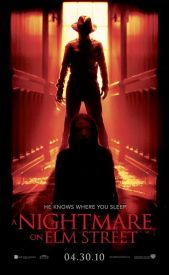
#111 - Gods And Monsters

#111 - Gods And Monsters

Dedicated To
Lynn Redgrave
1943 - 2010




Added 5/03/10
Welcome back to the Electric Theatre. We’ll get to this week’s offerings in a moment but first, I hope you’re all remembering to keep an eye out for Exit Through The Gift Shop, the wildly funny art-world documentary by Banksy I reviewed here a couple weeks ago. This is one of the most entertaining non-fiction movies you’ll ever see but it’s the kind of movie you’re going to have to search for. It’s been rolling out to major markets over the last few weeks with more to come. Visit the movie’s official website to see if and when it’s coming to a theatre near you. You won’t regret it.
NOW IN THEATRES
A Nightmare On Elm Street

At this point, it’s redundant to say you’re not a fan of remakes. Nobody is. Yes, you can trot out the usual list of good remakes but they are clearly exceptions to the rule. Particularly in the last decade, the remake has degenerated into a black hole that sucks all creativity and life out of familiar properties and one of the most egregious offenders has been Michael Bay’s Platinum Dunes. For the most part, I’ve chosen to ignore the company’s output. Remakes of The Hitcher and Friday The 13th held little appeal, even as a cautiously optimistic horror fan. But A Nightmare On Elm Street is different. I’m an unapologetic fan of Freddy Krueger. I even enjoy the bad entries in the series, of which there are several. At worst, I figured the remake would be a bad movie that I still thought was kind of fun. At best, there was an opportunity to bring Freddy back to his genuinely scary roots. So how did director Samuel Bayer and team manage to come up with something as massively sucktacular as this?
Perhaps the remake’s fatal flaw is that it tells the same basic story as the original as though we’ve never heard it before. OK, so now instead of a child-murdering power-plant worker, Freddy (Jackie Earle Haley) is a child-molesting gardener at a preschool. That’s fine but it’s not enough of a change to warrant dragging things out as much as is done here. Freddy is a familiar character and he hasn’t been missing in action all that long. Even people who don’t see horror movies know who Freddy Krueger is and get the general idea. There’s no mystery or suspense in the discovery of who is haunting the kids’ dreams, just tedium as we wait for them to figure out what we already know. Even worse, Bayer restages some of the most iconic imagery from the original and not well. The movie announces how lousy it’s going to be when Bayer “reimagines” the classic scene of Freddy appearing in the wall above a bed. In Wes Craven’s version, this is accomplished with simple stagecraft techniques. It’s elegant, it’s easy, and it’s very effective. Here, the wall morphs into a poorly rendered CGI wallpaper monster. As ridiculous as the Nightmare sequels became, they never repeated themselves. What made them enjoyable was the creative, how-do-we-top-this Freddy imagery. We’ve seen everything in this movie before.
As Freddy, Jackie Earle Haley gives it the old college try and makes an admirable attempt at stepping out of Robert Englund’s shadow. But his performance is undermined by makeup that renders his face immobile. Englund’s Freddy was one of the most expressive monsters around. He laughed, his face broke into a demonic grin, and his rage was visible. Haley’s Freddy can barely open his mouth to speak. The rest of the cast fares much, much less well. They’re a bunch of interchangeable 20-somethings impersonating high school students, although none of them look like they’ve been carded at a bar in the past couple years. Heather Langenkamp’s sympathetic and resourceful Nancy has been replaced by Rooney Mara, a withdrawn artsy type who reacts to news of her friend’s death the same way she responds to being asked out on a date. Across the board, calling the performances of these alleged “kids” wooden is an insult to trees.
Admittedly, Samuel Bayer has a keen visual sense and it’s served him well in his years of making music videos for the likes of Nirvana, Green Day and others. And there are plenty of great filmmakers who got their start making videos, including Spike Jonze, Michel Gondry, David Fincher and many more. But Bayer’s skill is not in narrative storytelling. He’s been directing videos and commercials since the early 90s and I suspect that if he had any real interest in feature films, he would have made one a long time ago. Freddy Krueger could have benefited from a director with a strong visual style, as long as that filmmaker also understood structure and pacing. Instead, this new Nightmare is a handsome looking but utterly vapid vortex of unoriginality. You can call it a remake, a reboot, a retread or a rehash but you can’t call it a reimagining. This Nightmare has no imagination. (*)
TALES FROM THE QUEUE
The Last Of Sheila

I first heard about this 1973 mystery, written by the unlikely duo of Stephen Sondheim and Anthony Perkins, from an appropriately unlikely source: an article on puzzle-addict Sondheim in an issue of Games magazine in the 80s. The movie sounded intriguing and I’d occasionally run across copies but for whatever reason, I never bothered to pick it up. Don’t make the same mistake I did. The Last Of Sheila is a top-notch whodunit that’ll keep you guessing until the very end.
James Coburn leads the all-star cast as a film producer whose wife is killed in a hit-and-run incident the night of a party at his house. One year later, he summons six guests from that party to spend a week on board his yacht in France. He’s prepared a series of elaborate games, assigning each one a secret that the others have to figure out using clues, treasure hunts and other games. But there’s more to the games…and the guests…than meets the eye.
The guests include Richard Benjamin and Joan Hackett as a hack screenwriter and his wife, both hoping to revitalize his sagging career. James Mason is a washed-up director, reduced to shooting dog-food commercials. Dyan Cannon plays a motor-mouthed Hollywood agent. Raquel Welch and Ian McShane round out the cast as a diva actress and her lap-dog of a husband/manager. The cast seems to be visibly enjoying themselves, none more so than Coburn. He presides over the proceedings with a devilish gleam, his toothy grin never far from his face. The script by Sondheim and Perkins, both legendary puzzle fans, is what really sets The Last Of Sheila apart. Too many mysteries don’t play fair with their audience, withholding clues and information until the last minute, making it impossible to solve the puzzle. Sondheim and Perkins, on the other hand, would consider that cheating. They give you everything you need to play along. Of course, they also don’t want to make it too easy, so there are ample red herrings to keep you on your toes.
Efficiently directed by Herbert Ross, The Last Of Sheila is a wonderfully entertaining example of the kind of smart, witty mystery that rarely gets filmed these days. It’ll have you on the edge of your seat, paying strict attention to every shot looking for clues that may (or may not) be there. It’s a parlor game masquerading as a movie, a film that’s as much fun to play as it is to watch. (* * * ½)
Thanks to Scott Shanks and Mychal Bowden for this week’s TFTQ recommendation! As always, please drop me an email with your suggestions for underrated or rarely seen gems or become a “liker” of the Electric Theatre on Facebook and tell me there. Any genre, any era, any language. So let it be written, so let it be done.
Your pal,
Jahnke
ajahnke@thedigitalbits.com